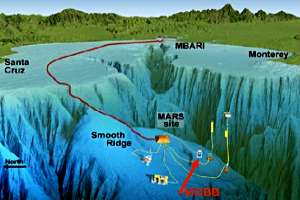 New instruments hook to the underwater lab.
New instruments hook to the underwater lab.
Credit: David Fierstein © 2005 MBARI
We heard about the Monterey Bay Aquarium Research Institute's new underwater laboratory in a radio story last fall. When that story aired, the lab (known as the Monterey Accelerated Research System, or MARS) was just getting going, with lots of neat experiments planned. Now, few of those have become a reality.
In case you missed the first story, the MARS is essentially an underwater data hub, perched on the ocean floor almost 3,000 feet below the surface of Monterey Bay. A 32-mile cable connects the system to land, acting as a power cord and data link. Several "underwater extension cords" allow a variety of instruments to plug into the hub, getting power from land and sending back data via the cable. That constant connection is a big step forward in undersea science; without it, researchers have had to use boats to stay physically close to their instruments (something hard to do for very long), or have sent the instruments off on their own, relying on batteries to keep them running and collecting data.
Until late February, earthquake scientists at the UC Berkeley Seismological Laboratory had been using that second method with their seafloor seismic station, the Monterey Ocean Bottom Broadband (MOBB). "We had to wait three months to even know if the instruments were alive," said Barbara Romanowicz, the lab's director. But the MOBB is now plugged in to the MARS system, and is transmitting its information about earthquakes in real-time.
That new stream of information could be especially valuable in California, because the MOBB provides a unique view of the main fault system, the San Andreas, which runs along the Northern California coast. Most seismometers are land-based, and therefore positioned on the east side of the fault. The MOBB is on the west side of the fault, offering a helpful perspective on the fault's shifts and shakes.
